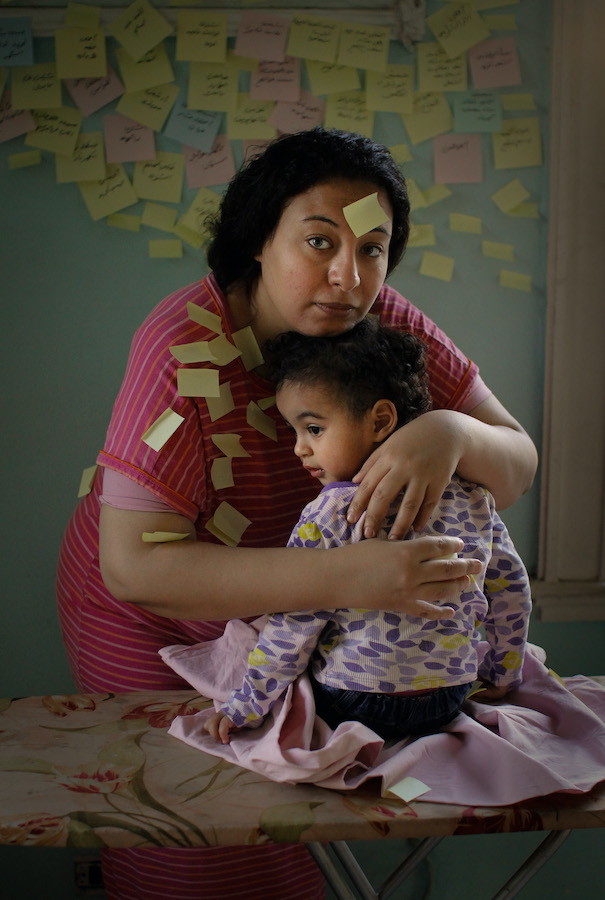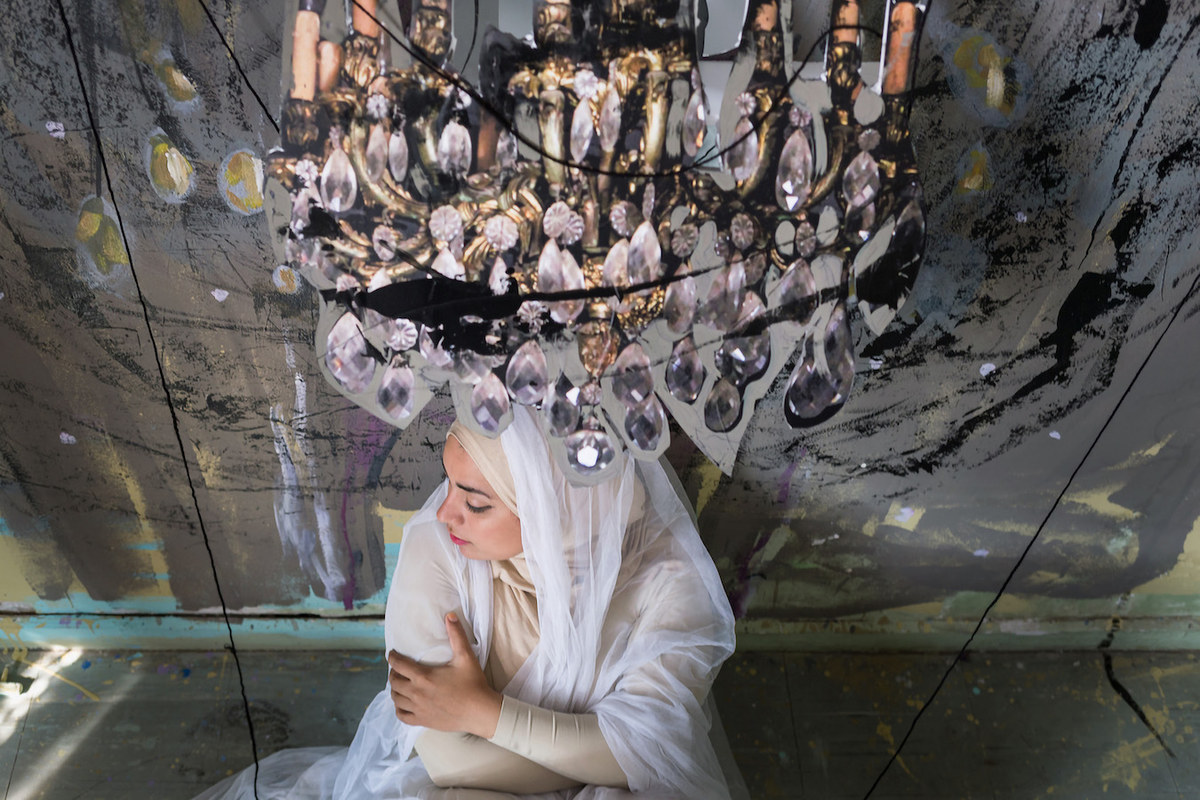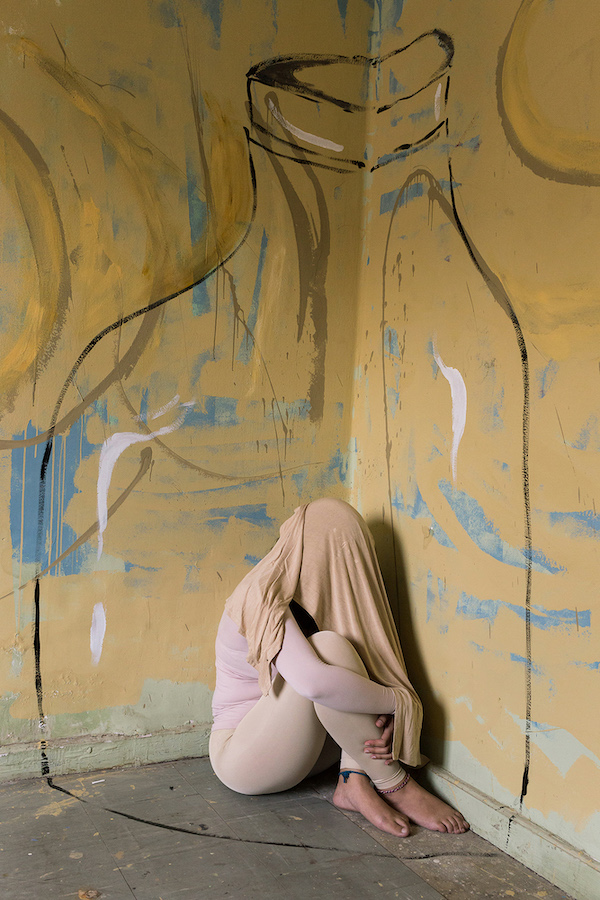DUBAI: An Egyptian woman with short brown curly hair sits cross-legged on the floor dressed in a nude bodysuit — clothing often worn by women in Egypt. In her lap, also in a nude bodysuit, is her daughter, upside-down with her feet extended towards her mother’s face. The woman stares out proudly while she holds a blue-and-white striped hula hoop around them both.
This startling and powerful work is a self-portrait called “Single Mother.” It is the work of Egyptian photojournalist Heba Khalifa and was most recently displayed by Cairo-based gallery Tintera at Photo London 2021 — the first time the artist’s work has been shown in the UK. Many of Khalifa’s works, including this one, focus heavily on the landscape of her body and the bodies of her subjects.

“From the Inside” tackles “the constraints of motherhood.” (Supplied)
“I am a single mother,” Khalifa writes in her artist’s statement for the work. “My daughter and I are one. She is always with me … My life is overloaded. I work six days a week and am all over the place doing acrobatics to be able to provide a shelter to my daughter.”
Khalifa, born in Cairo in 1977, is a multimedia artist, photojournalist and painter. Her own divorce has led to her to document and represent women and gender issues through her art. “It was so difficult; I was so depressed,” she tells Arab News of the experience. “My child was only two at the time. I was told I couldn’t go back to live with my family, and I had to take responsibility for my life.” Khalifa had to start from scratch on her own.

Her own divorce has led to her to document and represent women and gender issues through her art. (Supplied)
She uses her work to explore her personal life. “When I became a woman (society pushed) me all the time to marry, to have children, to be pretty, to smile in this way, to act in this way,” she says. “I felt I was always a failure. I saw my body as the enemy — as a burden for me. I fought with my body.” Khalifa started a Facebook group with friends and friends of friends — all women to discuss “What it means to be a woman.” They shared many stories of hardships, hopes, dreams, disappointments and struggles and this inspired her to focus her work on women and the issues they face in Egyptian society.
One of her series, “From the Inside,” tackles “the constraints of motherhood,” while her 2016 series “Homemade” (of which “Single Mother” is a part), tells the personal stories of women from the Facebook group she had created. In it, Khalifa allows her (anonymous) subjects to act out their hopes, dreams, fears, and struggles using props, paint, and collage. The resulting photographs offer poignant portrayals addressing subjects that are rarely publicly discussed in the Arab world — childrearing, abortion, body-image issues, abuse, and gender inequality. All the women in “Homemade” wear full bodysuits, often with their faces entirely covered.

Khalifa’s work is cathartic not only for the women she portrays, but for herself. (Supplied)
“The bodysuits are symbolic,” Khalifa says. “They serve as a metaphor for the feeling and idea of being trapped and imprisoned by one’s body and one’s circumstances as a woman.
“From a young age we are told how to act, how to sit, what to say and then told that, when we become women, we need to have children and get married by a certain age,” she continues. “When we go outside, we are told to be careful of how people look at us. There’s always this fight between how you look and how the ‘ideal woman’ looks. I have a fight in my mind about these things.”

Many of Khalifa’s works, including this one, focus heavily on the landscape of her body and the bodies of her subjects. (Supplied)
Khalifa’s work is cathartic not only for the women she portrays, but for herself. “I want to give a voice to myself, finally. And to others,” she says.
Her photographs are at once vulnerable and brave acts of expression. The intimate side of herself Khalfia shows, as well as those of her anonymous sitters, reveals pain, trauma, and disappointment, but with grace and courage. Khalifa’s art gives women a safe platform where they are, however briefly, free to be themselves.
“If you dig deep enough inside yourself to express what is there,” she says, “you also express (the feelings and thoughts) of other people.”












